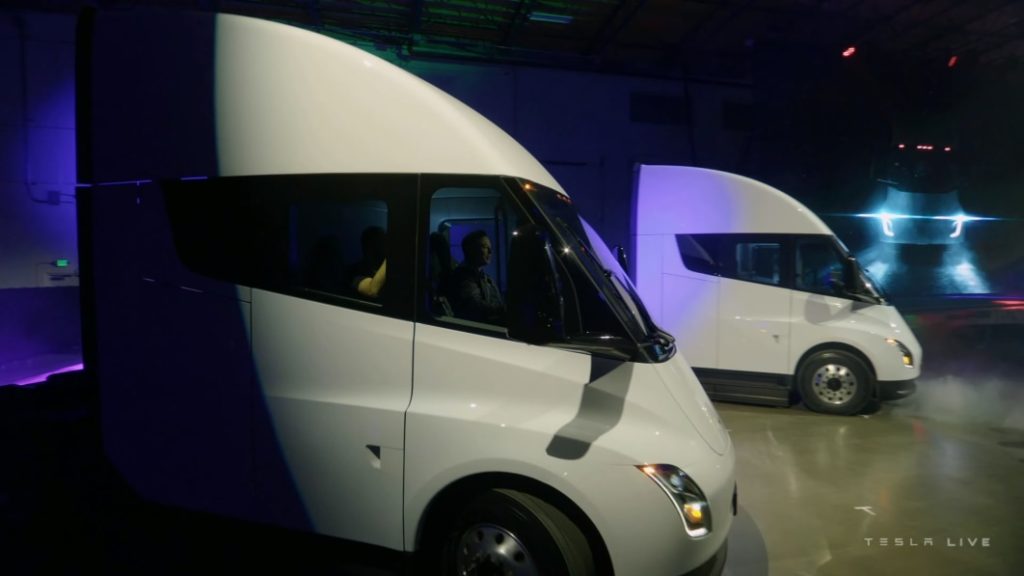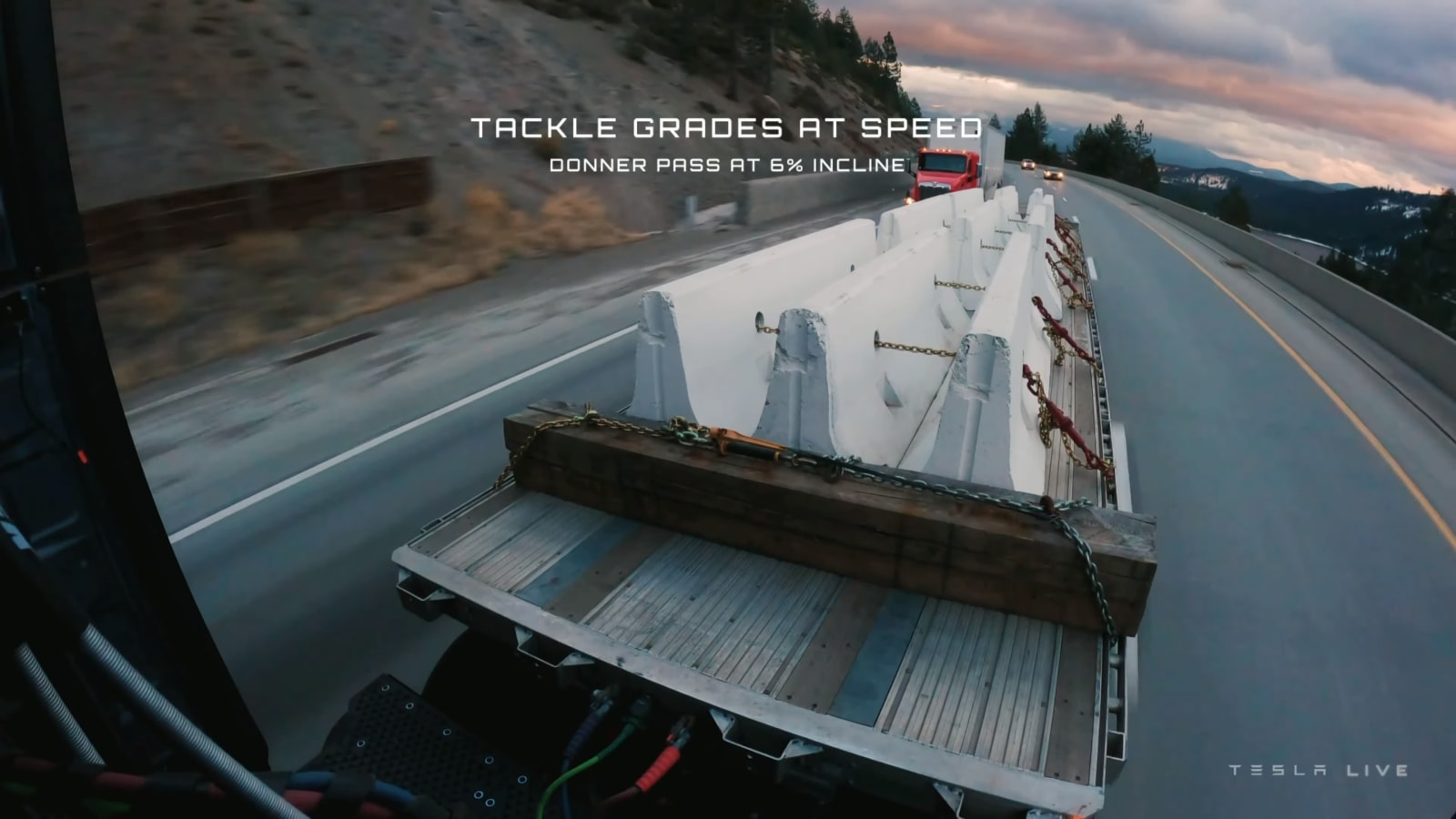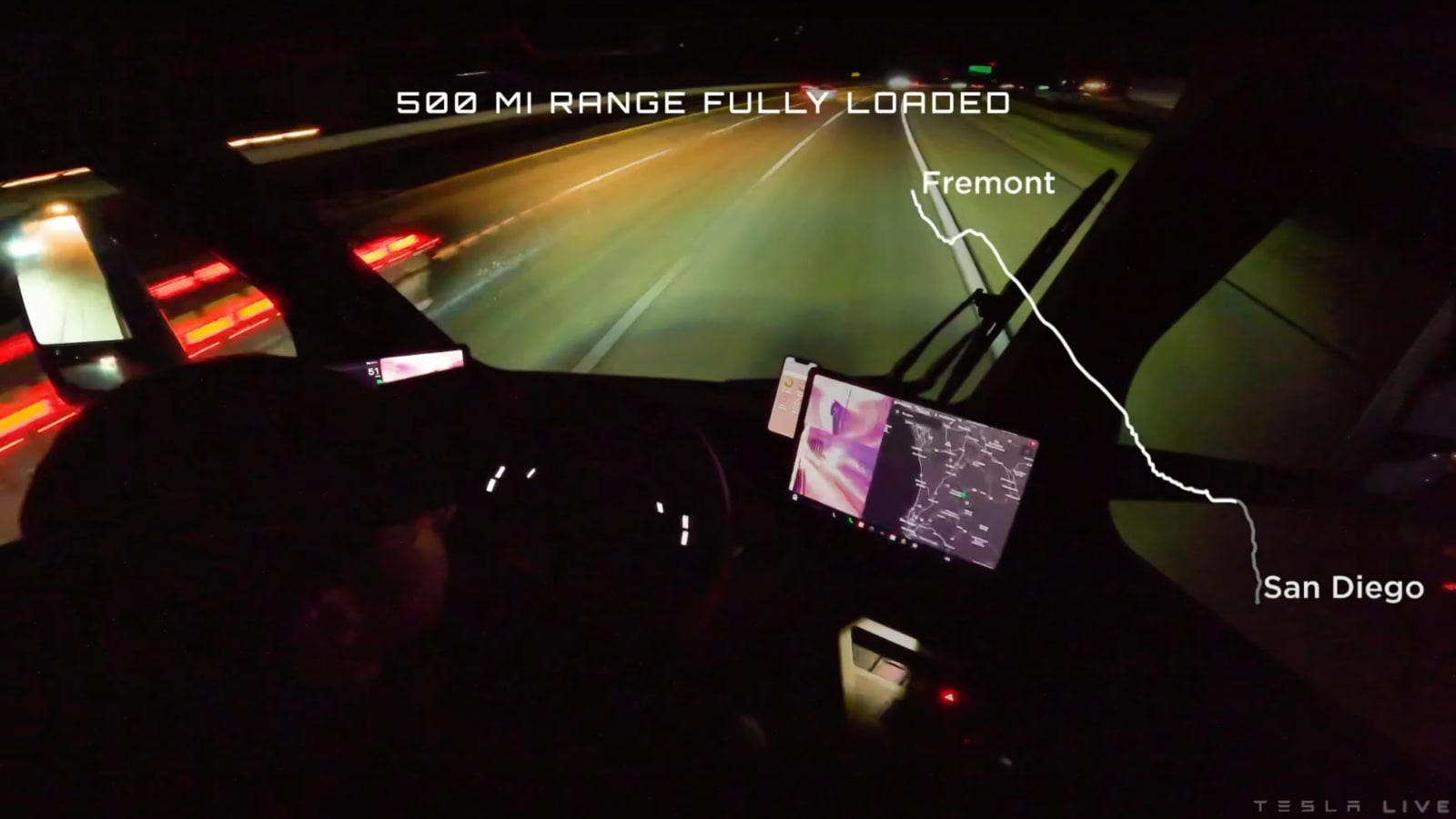Let’s talk about the Tesla Semi (again) …

Tesla CEO Elon Musk and Tesla Semi Senior Engineering Manager Dan Priestly took the stage last night – the stage being a flatbed trailer – to announce the arrival of the Tesla Semi. As everyone has noted, this is five years after Musk announced the Semi and three years after Musk said the Semi would enter production.
After the 2017 debut, I wrote a piece asking some questions about the rig, especially concerning some of its more unusual elements like the central seating position and doors behind the driver. I’d spent nine months of that year driving an over-the-road truck more than 70,000 miles in the United States and Canada for two companies. After last night’s presentation, most of those questions remain. But let’s consider what happened last night.
I’ll start by saying congratulations to Tesla the same way I’ve congratulated every other aspiring and established automaker for getting a hot product out the door finally (such as Lordstown Motors). Making cars is hard. The times are harder.
Now to the breakdown.
“The Future of Trucking.”
– Tesla Semi web site
If the Semi ends up being the future of trucking, we won’t know for another decade or so. More importantly, the Tesla Semi as-is could only be the future of a certain kind of trucking, bringing us to the first issue we need to clear up: The word “Trucking.”
That word makes people, even truckers, think of long-haul, over-the-road tractor-trailers with drivers who sleep in truck stops and don’t see their families but once every couple of months. Those tractors are called “sleepers,” referring to the area behind the seats that contains a bed where the driver, well, you can guess what he or she does there.
The Tesla Semi is not that. The Semi is what’s called a “day cab.” This is for regional work, like moving goods between locations a few hundred miles apart. In the early mornings you’ll see day cabs delivering food and drink from local warehouses to restaurants. On interstate highways in the wee hours, you’ll probably pass or be passed by numerous FedEx day cabs running parcels from one sorting depot to another. They’re cabs and a couple of seats, often a window in back you can see the occupants through. Those drivers go home every day at the ends of their shifts.
Truckers drive thousands of miles per week all over North America and sleep in their trucks. Daycabbers drive regional routes and sleep at home. The Semi serves the latter.
“This is a step-change improvement.”
– Elon Musk, December 1
This could be true, but there’s some context – and it needs on-road proof.
The Semi isn’t the first electric truck, nor is it the only one fitted with three motors. The only reason it gets so much ink is because it’s a Tesla. That’s not hate. Celebrity and industry-defining products have their perks.
But Daimler truck division Freightliner has an eCascadia Class 8 rig plus an electric school bus and an electric box truck. Nikola has its Tre BEV. Volvo-owned Renault Trucks has an even wider selection of e-rigs than Daimler, but in Europe. The Daimler can pull the same 82,000 pounds as the Tesla.
The step change would be the real-world range and the ecosystem – the unique selling proposition that made Tesla, Tesla as far back as the debut of the Model S. The eCascadia is listed with a typical range of 220 miles with tandem drivers (the two axles behind the cab) or 230 miles with a single axle in long-range configuration. Daimler’s max battery capacity is 440 kWh. The Tre BEV uses a 733-kWh battery to go 330 miles. The European Renault over-the-road T E-Tech truck can go 186 miles on a charge. The Renault’s max battery capacity is 540 kWh.
Mixing those battery figures with Tesla’s claim that the Semi uses less than 2 kWh of battery capacity per mile, it’s clear the Tesla’s packing a whole lot more battery than those other trucks.

“Not very impressive – moving a cargo of chips (average weight per pack 52 grams) cannot in any way be said to be definitive proof of concept.”
– Oliver Dixon, a senior analyst at consultancy Guidehouse, to Reuters
Fluff isn’t always positive, and I don’t understand Dixon’s complaint. Yes, we’re missing a lot of info. But PepsiCo, which owns Frito-Lay, is the Semi’s first customer. Frito-Lay makes chips. Those chips have to get from the factory to distribution centers and stores. Diesel trucks take them there. Our guess is that right now, a few Semis are on the job, too. It’s not Tesla’s fault that Frito-Lay needs to haul chips.
As for proving the concept, Musk and Priestly showed video of a Semi pulling a flatbed load of highway dividers over the Donner Pass, a 6% grade in northern California. They also showed a timelapse video of what they said was a full load of nearly 82,000 pounds being driven from Fresno to San Diego.
Pepsi weighs a lot more than Cheetos, and Pepsi knows this. The company would have nixed the deal years ago if it didn’t believe the truck could pull a bunch of Pepsi.
“To have cold brakes at the bottom of the hill, that’s mind-blowing in the trucking world”
– Elon Musk
“You just end up heating brakes and then you can’t use them.”
“It’s a safer system because no gear to miss.”
– Dan Priestly
The pair were talking about how regenerative braking would make descending long grades easier for drivers. There’s truth to this, but it’s overblown.
At the top of a long descent, the trucker puts the transmission in the proper gear for the descent. When I drove over the Grapevine grade down into California’s Central Valley five days a week, I’d slow down at the top of the hill and use the paddle shifters to put the truck into fourth or fifth gear (out of eight) for the descent heading north. The truck would hit about 45 mph, the speed limit, and hold there. If I needed to slow down, I’d tap the left paddle to drop a gear. I wouldn’t touch the brakes the entire descent.
Any driver in a hilly area who still has a job after seven days of driving knows how to handle grades. The key is the slowdown at the top of the hill. Drivers mess up when they forget that part, but unless they’ve run up to ludicrous speeds, the brakes will still slow the truck enough to downshift. Everyone else on the road will smell when that’s happened, though.
No one cares about cold brakes at the bottom of the hill, but almost any step that makes life easier for truckers is a fine step.

“We also have excellent traction control because the precision of an electric motor is vastly better than a diesel engine. … The traction control is really awesome … It’s automatically stopping the truck from jackknifing [in a way] that just isn’t possible with diesel trucks.”
– Elon Musk, December 1
This is a step back from Musk’s 2017 claim that “Jackknifing is impossible,” and there’s truth to this, but it’s still overblown.
What’s overblown is that electric motors can’t beat the physics of a tractor-trailer. We don’t know what the Semi weighs. Volvo’s VNL 300 tandem day cab rig weighs about 16,500 pounds. The federal government’s Consolidated Appropriations Act makes an additional gross weight allowance for electric trucks of 2,000 pounds. That’s why the Semi and every other electric Class 8 truck can pull up to 82,000 pounds and still be legal. If we add 2,000 pounds to that VNL 300, we’re at 18,500 pounds. Let’s say the Semi is 20,000 pounds with all that battery, to be safe, leaving a potential 62,000 pounds for the load. If things go bad for the Semi driver and the 62,000-pound trailer starts pushing the 20,000-pound tractor around, the galaxy’s fastest traction control won’t stop a jackknife even in good weather. Even if the Semi is 25,000 pounds, you’ll get the same result.
What’s true is that an electric motor on an axle will make faster adjustments and therefore likely more precise adjustments, than a diesel ECU that has to receive and register the wheel slip information and then send a command to the engine and/or brakes. This can raise the threshold for the possibility of a jackknife incident, which is a good thing.
“One-touch suspension dump, it’s very easy for the driver to attach the trailer, it saves time and money, the fleet’s more efficient, and the driver’s home sooner.”
– Dan Priestly
I have never been in a Class 8 truck that didn’t have a way to empty the air bags to lower the chassis. I share a storage unit with a friend who drives a 1999 Peterbilt 379. It has a toggle for lowering the chassis. Without it, hooking up that busted trailer in the back of that yard you absolutely hate going to would be impossible without a forklift or two.
“It’s as easy to drive as a Model 3. With basically no training, you can drive this.”
– Elon Musk
A trained sheep – or pretty close – could drive a tractor-trailer on the highway. Truckers go through all that training so they can learn to drive in a city without killing everything, to drive backward, to park between other trucks, to manage the air-based systems, to pre-check for roadworthiness, and to fill out the stacks of paperwork required to move loads and stay legal.

About that video…
Musk and Priestly showed a timelapse video of the Semi doing a 500-mile run from Fremont to San Diego, with Musk saying the entire, uncut video will eventually hit YouTube. We really want to watch it. A graph displayed at the presentation said the Semi departed with a 97% charge and arrived with 4% of charge remaining. Problem is, the driver’s wearing a baseball cap that occasionally obscures the left-side screen that contains the speedo, which seems … highly coincidental. If the camera were placed lower, like it is in a later section of video where the driver’s doing a constant 55 mph, or if it were placed anywhere on the left side of the cab, or if the driver weren’t wearing a hat, we’d see the speedo the entire time.
The numbers we can see show what looks like some tenderfoot driving. Keeping in mind that the speed limit for Class 8 trucks is 55 mph in California, the Semi did 55 or below for the opening stint; at one point doing 29 mph on what looks like open highway. The driver follows another rig on I-5 at about 60 to 65 mph for a spell, up to about the one-third mark in the trip. Then he locks into 55 or 57 mph for the long stint through central California, dropping as low as 44 mph and 39 mph for a surprising length of time.
For the final 100-mile stretch from Riverside to San Diego, after the driver takes his mandatory break, he doesn’t exceed 51 mph in the video, dropping as low as 47 mph on open highway.
We gotta watch the whole uncut thing, but it seems like if you see the Semi on the interstate, look for it in the slow lane.
Conclusions
Picking up my questions from five years ago, I still don’t want to sit in the middle of the truck. I’d like the windows – at least two of them – to roll down. I wish the doors weren’t behind the driver. And I hope I can turn at least one of those screens off. But I did get the physical mirrors.
The real judges of the Tesla Semi will be the companies that buy it, and after Pepsi, that waiting list includes blue chips like UPS and Anheuser-Busch. The Semi website claims “estimated fuel savings of up to $200,000 within [the] first three years of ownership.” That means that for every 15 trucks in the fleet, the fleet owner is saving $1 million.
If Tesla can come close to that, no matter what I say, Tesla won’t be able to build these fast enough. And I can’t wait to drive it.



